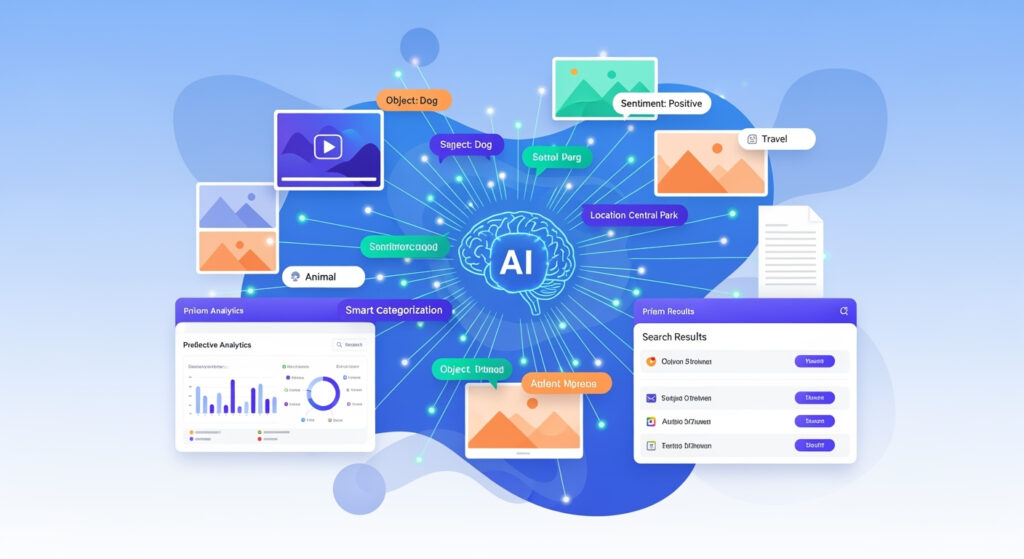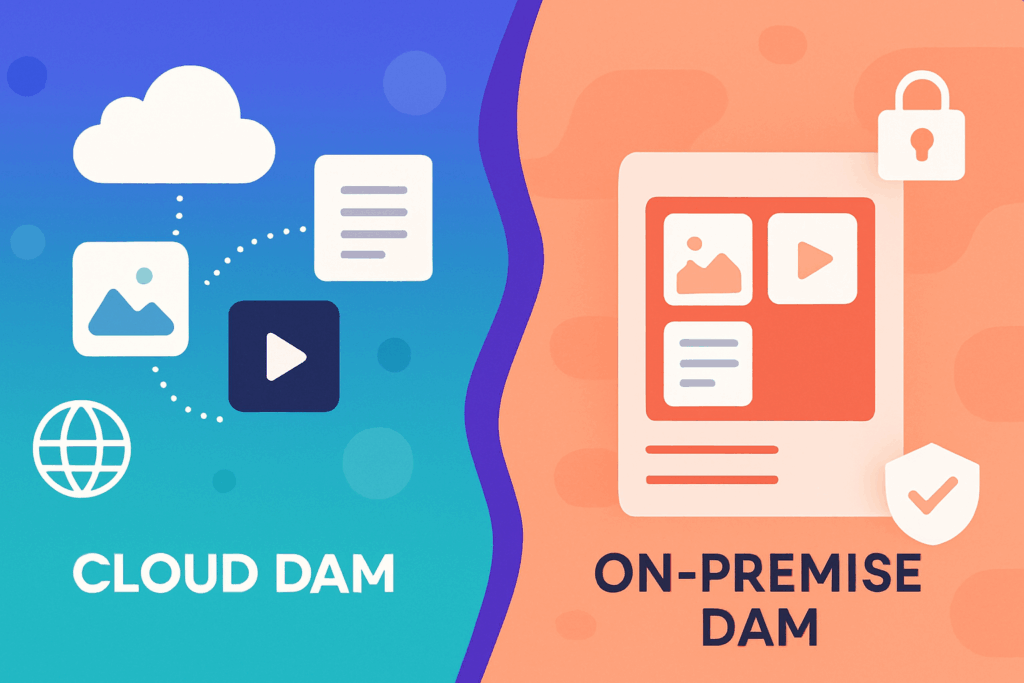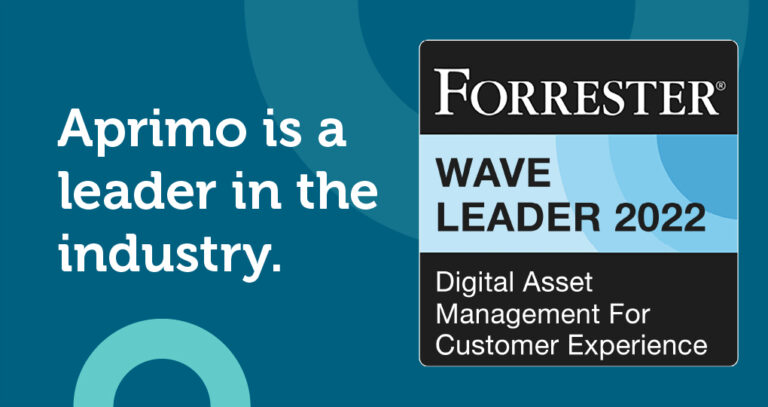Digital Asset Management: Everything You Need to Know

Key Takeaways
Digital asset management platforms have evolved into AI-powered content operations systems, with the global market expected to grow from $5.3 billion in 2024 to $10.3 billion by 2029.
- AI-powered automation is transforming metadata creation, asset discovery, and content workflows, with intelligent platforms reducing asset search time by up to 40%
- Cloud-based DAM systems dominate the market, offering scalability and remote collaboration capabilities that on-premise solutions can’t match
- Content personalization and real-time decisioning capabilities separate leading platforms from basic file storage solutions
- Compliance and governance features are now essential for regulated industries, with platforms supporting GDPR, FINRA, FedRAMP, and FDA requirements
What Is Digital Asset Management?
Let’s start with the basics. Digital asset management (DAM) has evolved significantly since traditional file storage systems, with modern platforms now serving as strategic foundations for digital business operations. According to IDC’s 2024 MarketScape analysis, today’s DAM systems integrate deeply with content management systems, e-commerce solutions, and creative suites to drive precise consumer interactions while using AI to help teams envision new concepts and reach new audiences faster than ever before.
Today’s DAM platforms serve as the central nervous system for enterprise content operations. Rather than just storing files like a fancy filing cabinet, these systems actively enhance your content through AI-powered automation, predictive analytics, and intelligent workflow management.
Think of digital asset management as the difference between having a messy garage where you can’t find anything and having a smart, organized workspace where everything you need appears exactly when you need it. The best DAM systems don’t just know where your content lives—they understand what it is, how it performs, and where it should go next.
According to TechTarget, modern DAM systems are ‘business processes for organizing, storing and retrieving rich media and managing digital rights and permissions’ that have evolved far beyond simple file storage.
- Create a single source of truth: All your digital assets live in one secure, accessible location—no more hunting through email threads or shared drives
- Automatically organize everything: AI-powered tagging and metadata management make every asset instantly discoverable
- Control who sees what: Role-based permissions ensure the right people access the right content at the right time
- Track every change: Complete audit trails and version control keep you compliant and organized
- Distribute intelligently: Automated content optimization and delivery across all your channels
- Measure what matters: Real-time analytics showing how your assets perform across different touchpoints
The transformation from basic file storage to intelligent content operations reflects a strategic shift in which content itself becomes a competitive differentiator in the digital economy. Leading organizations now view DAM as the foundation for scalable content operations that support personalization, omnichannel experiences, and data-driven decision-making.
Why Do Organizations Need Digital Asset Management in 2025?
If you’ve ever spent 20 minutes looking for that one product photo you know exists somewhere, you already understand the DAM problem. Now multiply that frustration across your entire organization, and you’ll start to see why companies are investing heavily in digital asset management solutions.
The numbers tell the story:
The global DAM market is expected to grow from $5.3 billion in 2024 to $10.3 billion by 2029 at a compound annual growth rate of 14.0%. That’s a fundamental shift in how organizations approach content.
The Content Volume Challenge
For marketing teams, that number can be even higher. When you’re creating content for websites, social media, email campaigns, print materials, and everything in between, the volume becomes overwhelming fast. Additionally, productivity research indicates that 90% of workers are burdened by repetitive tasks that can be automated, including searching for and organizing digital assets.
But it’s not just about volume anymore. Today’s content needs to work across multiple channels, support personalization at scale, and stay compliant with evolving regulations. Your smartphone photo folder might work for personal use, but enterprise content operations require something much more sophisticated.
The Remote Work Reality
When your creative team is in one city, your marketing team is in another, and your external partners are scattered across the globe, you need systems that keep everyone working with the same, up-to-date assets.
AI-Powered Expectations
Today’s users expect Google-level search capabilities within their content systems. According to Mordor Intelligence research, AI automation is cutting asset search time by up to 40%, with McKinsey research showing that 71% of organizations are now regularly using generative AI in at least one business function.
The organizations mastering intelligent digital asset management are seeing measurable competitive advantages: faster campaign launches, consistent brand experiences, and maximum value extraction from every piece of content they create.
Business Impact
Traditional File Storage
Modern DAM Platforms
Time to Find Assets
15-30 minutes per search
2-3 minutes average
Brand Consistency
Manual compliance checking
Automated governance rules
Content Reuse
20-30% of assets reused
60-70% asset optimization
Campaign Launch Speed
Weeks to coordinate
Days with automated workflows
What Features Should You Look for in a DAM System?
Not all DAM platforms are created equal, and the differences can make or break your content operations. The most effective systems combine rock-solid content management capabilities with cutting-edge AI automation that actually makes your team’s life easier.

Core DAM Capabilities That Actually Matter
Smart Metadata Management
Gone are the days of manually tagging every single asset. Leading DAM platforms use computer vision and machine learning to automatically generate rich, searchable metadata for everything you upload. These systems analyze visual content to identify objects, colors, faces, and contextual elements while extracting key information from documents through natural language processing.
According to TechTarget, this automated approach eliminates “time-consuming and inconsistent” manual tagging while ensuring consistent categorization standards across massive content libraries. The smartest platforms actually learn from your organizational usage patterns to improve tagging accuracy over time.
Intelligent Search That Actually Works
Professional DAM systems support way more than basic keyword searches. Users can find content through visual similarity searches, natural language queries, color matching, and contextual relationships between assets.
The best platforms let you search by uploading a reference image or describing what you need in everyday language. Instead of remembering exact file names or folder structures, you can search for “red jacket from fall campaign” and actually find what you’re looking for. This transforms content discovery from a technical skill into something anyone can do intuitively.
Enterprise-Grade Permissions Without the Headaches
Modern DAM platforms provide sophisticated user management that controls access, editing rights, and distribution permissions at granular levels, without making it complicated for everyday users.
These systems support role-based permissions, geographic restrictions, and compliance requirements specific to regulated industries. The most advanced platforms include automated compliance checking against brand guidelines, legal requirements, and industry regulations like GDPR, FINRA, and FDA standards.
Version Control That Prevents Disasters
Professional DAM systems maintain complete asset histories while establishing relationships between different versions and related content. When core assets get updated, intelligent platforms automatically notify stakeholders and suggest which downstream materials might need refreshing.
This prevents the nightmare scenario where someone uses last year’s logo on this year’s campaign because they didn’t know it had been updated.
AI and Automation Integration
The integration of artificial intelligence represents the biggest game-changer in DAM technology. Organizations increasingly migrate from on-premises systems to cloud-based DAM platforms to leverage AI capabilities and real-time collaboration features.
Predictive Metadata That Learns Your Brand
Machine learning algorithms analyze visual and textual content to automatically generate accurate, brand-specific metadata tags. These systems understand your organizational terminology and maintain consistency across massive content libraries without human intervention.
The really smart platforms learn from how your team actually uses content, getting better at tagging and organizing over time. It’s like having an assistant who learns your preferences and gets more helpful the longer they work with you.
Content Performance Intelligence
AI-powered DAM platforms track how assets perform across different channels, campaigns, and audience segments. This intelligence helps content teams identify which creative elements drive engagement, optimize content strategy, and predict which assets will resonate with specific audiences.
Instead of guessing what works, you get data-driven insights about which types of imagery drive engagement, what formats work best for specific audiences, and where content gaps exist in your current library.
Workflow Automation That Actually Saves Time
Smart DAM systems automatically route content for approval, optimize images for different channels, and generate content variations based on your business rules. Research from Salesforce notes that 93% of IT workers using automation tools are more satisfied with their productivity, while automation can reduce costs by 10-50% by reducing labor costs and manual processing.
The most sophisticated platforms include real-time content personalization capabilities that automatically deliver optimized asset versions based on audience data and performance analytics.
Who Needs a Digital Asset Management System?
Digital asset management delivers measurable value across multiple organizational functions, but the specific benefits vary depending on your role, industry requirements, and operational scale. While DAM can benefit many teams, four groups consistently drive the most value and ROI from these platforms.
Marketers
Modern marketers juggle content across more channels than ever before. They need systems that help them find the right assets quickly, maintain brand consistency, and track performance across all touchpoints.
According to McKinsey research, AI adoption in businesses increased by 22% between 2023 and 2024, with sales and marketing teams adopting generative AI most heavily at 71% adoption rates.
Marketers benefit most from automated brand compliance checking, campaign performance tracking, and content intelligence that helps optimize strategy across channels. The ability to quickly create content variations for different audiences and channels while maintaining brand standards becomes absolutely crucial for campaign success.
IT Leaders
IT leaders evaluating DAM solutions prioritize security, compliance, and integration capabilities above all else. They need platforms that support single sign-on authentication, detailed audit trails, and compliance with industry-specific regulations without creating additional administrative burden.
Modern DAM systems serve as integration hubs, connecting content repositories with CRM systems, marketing automation platforms, and content management solutions. This connectivity enables automated personalization workflows that would otherwise require significant custom development.
Many businesses have automated at least one function, with IT leaders recognizing that DAM platforms reduce their team’s workload by eliminating content-related support tickets while providing necessary governance and security controls.
Content Operations Teams
This is often the group that drives DAM adoption because they feel the pain of scattered, disorganized content most acutely. Content ops teams need platforms that provide process automation, performance analytics, and workflow optimization across the entire content lifecycle.
The best DAM platforms for content operations include features like automated content routing, performance tracking across channels, and integration with project management tools that help streamline the entire content creation and distribution process.
These teams particularly benefit from AI-powered automation that eliminates manual tasks. Workflow automation can help organizations achieve ROI within 12 months of implementation, with substantial productivity increases in automated processes.
Creative and Content Teams
Creative professionals need efficient systems to organize, version, and collaborate on content with internal stakeholders and external clients. The best DAM platforms integrate seamlessly with creative software while providing collaborative review tools and client presentation capabilities.
For creative teams, features like automated backup, real-time collaboration, and integrated approval workflows eliminate administrative overhead while maintaining creative focus on high-value activities. McKinsey research shows that automation already has the technical potential to handle about an hour of daily activities as of 2024, allowing creative professionals to focus on strategic, high-value work.
Creative teams also appreciate DAM systems that maintain creative asset relationships and provide intelligent suggestions for similar or complementary content, helping them work more efficiently while maintaining consistent quality standards.
User Role
Primary Benefits
Key Features Needed
Marketing Leaders
Brand consistency, campaign speed
Governance tools, performance analytics
Creative Teams
Workflow efficiency, collaboration
Version control, creative software integration
IT Directors
Security, compliance, integration
Enterprise security, audit trails, API capabilities
Content Operations
Process automation, scalability
AI automation, workflow management
Should You Choose Cloud-Based or On-Premise DAM?
The deployment model decision significantly impacts implementation timelines, total cost of ownership, and long-term scalability. Here’s the practical reality: most organizations today favor cloud-based Software-as-a-Service (SaaS) DAM platforms, but specific use cases still benefit from hybrid or on-premise approaches.

Why Do Most Organizations Choose Cloud-Based DAM?
Implementation Speed That Makes Sense
SaaS DAM platforms typically launch within weeks rather than months. Cloud providers handle infrastructure management, security updates, and system maintenance, letting your team focus on content strategy rather than server management.
Predictable Costs Without Surprises
Cloud DAM solutions operate on subscription models that provide predictable monthly or annual costs. You avoid large capital expenditures for hardware and software licenses, and regular feature updates, security patches, and technical support are typically included.
Global Access Without VPN Headaches
Cloud platforms enable secure access from any location with internet connectivity, supporting distributed teams and remote collaboration requirements that have become standard in modern organizations.
The user experience is also typically much better with cloud platforms. They’re designed for web browsers and mobile devices rather than being desktop applications adapted for web use.
When Should You Consider On-Premise DAM?
Despite the cloud trend, specific scenarios still favor on-premise or hybrid DAM deployment:
Strict Regulatory Requirements: Organizations in highly regulated sectors like defense, healthcare, or financial services may face data residency requirements that mandate on-premise storage. Some compliance frameworks require physical control over where data resides.
Massive File Volumes: Companies working with extremely large video files or extensive media libraries might find that bandwidth limitations make cloud transfer impractical for daily operations. If you’re regularly working with 4K video files or massive design assets, upload and download times can become prohibitive.
Existing Infrastructure Investments: Organizations with significant investments in on-premise infrastructure and dedicated IT teams may prefer maintaining direct control over content repositories.
Advanced Security Policies: Some organizations with stringent security requirements prefer maintaining complete control over access protocols and data management procedures.
The choice between cloud and on-premise deployment should align with your broader organizational technology strategy, compliance requirements, and resource availability rather than just cost considerations.
Which Industries Benefit Most from Digital Asset Management?
Different industries leverage digital asset management systems to address unique operational challenges, compliance requirements, and content complexity demands. Here’s how DAM plays out in practice across key sectors.

Retail and E-commerce Operations
Retail organizations manage vast product catalogs requiring multiple images per item, seasonal variations, and frequent inventory updates across numerous sales channels. DAM systems help retailers maintain accurate, current product information while supporting rapid merchandising changes.
Advanced retail DAM platforms integrate with product information management (PIM) systems to automatically update product imagery when specifications change. Some systems use AI to generate product descriptions, recommend complementary items, and optimize images for different marketplace requirements.
The challenge for retail goes beyond volume to include consistency across channels. Your product needs to look the same whether someone sees it on your website, in your app, on Amazon, or in your email campaigns.
Life Sciences and Healthcare
Healthcare and pharmaceutical organizations operate under strict regulatory oversight, which requires detailed documentation and approval workflows for all patient-facing content. DAM systems in these industries must support medical legal review (MLR) processes while maintaining complete audit trails.
According to automation research, nearly 80% of healthcare providers plan to significantly increase their digital solution investments within five years. These solutions will include specialized features such as automated compliance checking against FDA guidelines and support for multi-language content distribution.
For these organizations, the audit trail and version control features of DAM systems aren’t nice-to-have—they’re regulatory requirements that can make the difference between passing inspections and maintaining market access.
Consumer Packaged Goods (CPG)
CPG companies manage complex brand portfolios requiring consistent visual identity across numerous products and markets. DAM systems help ensure packaging consistency, support rapid product launches, and enable efficient content localization.
CPG-focused DAM platforms often include specialized features for packaging artwork management, nutritional information tracking, and regulatory compliance across different geographic markets with varying requirements.
The complexity here comes from managing the same product across different markets, languages, regulatory requirements, and packaging sizes, but with the same core brand identity.
These industry-specific requirements highlight the importance of choosing DAM platforms with deep vertical expertise and proven compliance capabilities rather than generic content management solutions.
How DAM Powers Modern Content Operations
Digital asset management serves as the foundation for comprehensive content operations strategies that encompass planning, creation, approval, distribution, and performance optimization across all channels. Here’s how it all works together in practice.
Integrated Content Lifecycles
Modern organizations view content creation as continuous processes rather than a discrete projects. Advanced DAM systems support this approach by maintaining relationships between different content types, tracking asset dependencies, and enabling efficient content repurposing across campaigns.
When product specifications change, intelligent DAM systems automatically identify all marketing materials referencing the updated information and notify relevant stakeholders about required changes. This ensures brand consistency at scale without requiring manual audits of every piece of content.
Omnichannel Content Distribution
Today’s consumers interact with brands across multiple touchpoints—websites, social media, email, print materials, and mobile applications. DAM systems enable consistent content experiences by automatically optimizing assets for different channels while maintaining brand compliance.
Advanced platforms automatically resize images, adjust color profiles, and modify messaging to meet channel-specific requirements while preserving core brand elements and maintaining approval workflows.
AI-Enhanced Content Operations
The integration of generative AI capabilities transforms DAM systems from passive repositories into active content creation partners. These systems can generate image variations, create social media captions, and produce initial concepts for creative review.
Leading platforms analyze content performance across channels to recommend optimization strategies, predict which creative elements will drive engagement, and automatically generate personalized content variations for different audience segments.
Content Operations Stage
Traditional Approach
AI-Powered DAM
Asset Creation
Manual design and copywriting
AI-assisted generation and optimization
Organization
Manual tagging and filing
Automated metadata and intelligent categorization
Distribution
Manual channel posting
Automated optimization and delivery
Performance Analysis
Quarterly reporting
Real-time analytics and optimization
How Do You Choose the Right DAM Platform?
Choosing a digital asset management platform requires a systematic evaluation of your current requirements, future growth plans, and organizational priorities across multiple stakeholder groups. Here’s how to approach it without getting overwhelmed.
Essential Evaluation Criteria
User Experience That People Actually Want to Use
The most feature-rich DAM system delivers no value if your team won’t use it consistently. DAM solutions should enhance the efficiency, security, and accessibility of digital assets while being intuitive enough for widespread adoption.
Test platform interfaces with actual end users, creative professionals, marketing coordinators, and external stakeholders who might access content through client portals. The best DAM systems feel familiar to users accustomed to consumer applications while providing professional-grade functionality.
Integration Ecosystem Depth
Modern DAM platforms must connect seamlessly with existing technology stacks, including creative software, marketing automation platforms, content management systems, and social media management tools.
Leading DAM providers offer pre-built connectors for popular applications, plus robust APIs for custom integrations. The most advanced platforms provide no-code integration tools, enabling marketing teams to create automated workflows without IT involvement.
Look for platforms that integrate with tools your team already uses daily. If you’re heavily invested in creative software, project management platforms, or specific marketing automation tools, make sure your DAM choice plays nicely with those systems.
Scalability and Performance Architecture
When evaluating DAM platforms, consider your current requirements and projected growth. Systems should handle increasing storage volumes, user counts, and API requests without performance degradation.
Cloud-based platforms typically offer more flexible scaling options, but organizations should evaluate performance characteristics for their specific use cases and geographic distribution requirements.
Security and Compliance Capabilities
Evaluate security features, including encryption standards, access controls, audit logging, and compliance certifications relevant to your industry. Organizations in regulated sectors should prioritize platforms with specific certifications like FedRAMP, FINRA, FDA, or healthcare compliance standards.
How Do You Successfully Implement a DAM System?
Cross-Functional Stakeholder Alignment
Successful DAM implementations involve representatives from creative, marketing, IT, legal, and executive teams from the initial planning stages. Each group contributes unique requirements and perspectives that influence platform selection and configuration decisions.
Don’t let one department drive the entire decision, or you’ll end up with a platform that works great for them but creates problems for everyone else.
Strategic Content Migration Planning
Most organizations underestimate the complexity of migrating existing content libraries to new DAM systems. Develop comprehensive migration strategies addressing file organization, metadata preservation, user access transitions, and workflow continuity.
Plan for this to take longer than expected and require more cleanup than you think. It’s worth doing right the first time rather than rushing and ending up with a messy system from day one.
Comprehensive Training and Change Management
Plan extensive training programs addressing different user roles and skill levels while creating internal champions who provide peer support and encourage adoption across teams.
The most successful DAM implementations combine appropriate technology selection with thoughtful change management processes that help users understand how new systems improve their daily workflows and business outcomes.
What’s the Future of Digital Asset Management?
Digital asset management continues evolving rapidly as emerging technologies reshape content operations and organizational expectations around intelligent automation and personalized experiences. The next few years will bring significant changes in both the technological capabilities of DAM platforms and the organizational requirements they need to address.

What Technologies Are Shaping DAM’s Future?
Agentic AI and Autonomous Content Management
The next generation of DAM systems will feature AI agents capable of managing routine content operations with minimal human oversight. These systems will automatically organize incoming assets, suggest content improvements, and create derivative works based on established brand guidelines.
Imagine uploading a product photo and having the system automatically create social media variations, optimize it for different channels, generate accompanying copy, and route it through appropriate approval workflows, all without human intervention.
Advanced Computer Vision and Content Intelligence
Improving computer vision capabilities enables more sophisticated content analysis, including emotional sentiment detection, brand compliance checking, automated quality assessment, and contextual content recommendations.
Future systems will understand not just what’s in an image, but the emotional context, brand alignment, and likely performance characteristics based on historical data.
Real-Time Content Personalization
Future DAM platforms will support dynamic content creation that adapts messaging, imagery, and formatting based on real-time audience characteristics, behavior patterns, and performance data.
This goes beyond simple A/B testing to dynamic content that adjusts itself based on who’s viewing it, when they’re viewing it, and what their interaction history suggests will resonate most.
Evolving Organizational Requirements
Content Personalization at Enterprise Scale
As personalization becomes more sophisticated, DAM systems must support dynamic content creation, adapting to individual user characteristics while maintaining brand consistency and compliance requirements.
Global Collaboration and Localization
International organizations need DAM platforms supporting multiple languages, cultural adaptations, and regional compliance requirements while maintaining centralized brand governance and approval workflows.
Sustainability and Content Lifecycle Optimization
Growing awareness of digital sustainability drives demand for DAM features optimizing file sizes, reducing storage redundancy, and managing content archival more efficiently while maintaining accessibility.
The organizations thriving in tomorrow’s content-driven marketplace will view digital asset management as strategic infrastructure, enabling competitive differentiation rather than simply storage technology.
Top 5 DAM Platform Selection Criteria
When evaluating digital asset management solutions, focus on these critical capabilities that separate industry-leading platforms from basic content storage systems:
1. AI-Powered Automation and Intelligence
Look for platforms that automatically generate metadata, optimize content for different channels, and provide predictive analytics about asset performance. The best systems learn from your usage patterns and continuously improve their recommendations.
2. Seamless Integration Ecosystem
Ensure your chosen platform connects with essential tools in your existing technology stack. Priority integrations include creative software, marketing automation platforms, CMS systems, and social media management tools.
3. Enterprise-Grade Security and Compliance
Verify the platform meets your industry’s specific regulatory requirements, whether that’s GDPR, FINRA, FDA, or healthcare compliance standards. Look for features like role-based permissions, detailed audit trails, and automated compliance checking.
4. Scalable Cloud Architecture
Choose platforms built for growth that can handle increasing storage volumes, user counts, and global collaboration requirements without performance degradation or significant cost increases.
5. Intuitive User Experience
The most feature-rich platform delivers no value if your team won’t use it. Test interfaces with actual end users to ensure the system feels familiar and productive rather than technical and complex.
Frequently Asked Questions
What is DAM software?
DAM software is a centralized platform that helps organizations store, organize, manage, and distribute digital assets like images, videos, documents, and multimedia content. According to TechTarget, modern DAM systems include AI-powered features for automated tagging, intelligent search, workflow automation, and content personalization.
Is DAM the same as a CMS?
No, DAM and CMS serve complementary but different purposes. A Content Management System (CMS) focuses on creating and publishing web content, while Digital Asset Management (DAM) systems specialize in storing, organizing, and distributing digital files. Leading organizations use both systems together, with DAM feeding optimized assets into CMS platforms.
What’s the difference between DAM and PIM?
DAM manages digital assets and media files, while Product Information Management (PIM) systems handle product data, specifications, and attributes. PIM systems often integrate with DAM platforms to connect product information with related imagery, marketing materials, and content variations across channels.
Can a DAM integrate with my marketing tools?
Yes, modern DAM platforms offer extensive integration capabilities with marketing automation tools, social media management platforms, content management systems, and creative software. Leading platforms support 70+ native integrations plus robust APIs for custom connections and workflow automation.
How much does DAM software cost?
DAM pricing varies significantly based on storage requirements, user counts, feature sets, and deployment models. SaaS platforms typically charge monthly subscription fees ranging from hundreds to thousands of dollars based on usage, while enterprise solutions may require custom pricing discussions based on specific requirements and scale.
Ready to Transform Your Content Operations?
The digital asset management landscape has never been more dynamic. Organizations that embrace AI-powered DAM platforms today position themselves to capture significant competitive advantages through streamlined workflows, enhanced brand consistency, and accelerated time-to-market.
Leading enterprises choose platforms that combine intelligent automation with comprehensive content operations capabilities. From predictive metadata generation to automated compliance checking, modern DAM systems deliver measurable ROI through reduced operational costs and increased content velocity.
Don’t let scattered assets and manual workflows limit your growth potential. Discover how modern DAM systems can streamline workflows, ensure brand compliance, and accelerate time-to-market across all channels.
Ready to transform your content operations with AI-powered digital asset management? Leading organizations choose platforms that combine intelligent automation with comprehensive content operations capabilities. Discover how modern DAM systems can streamline workflows, ensure brand compliance, and accelerate time-to-market across all channels.




